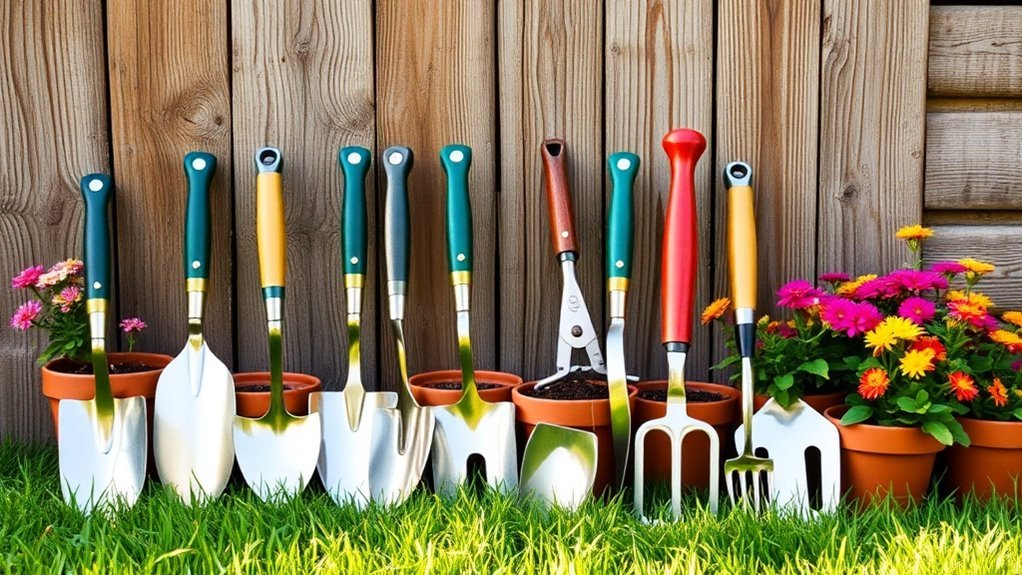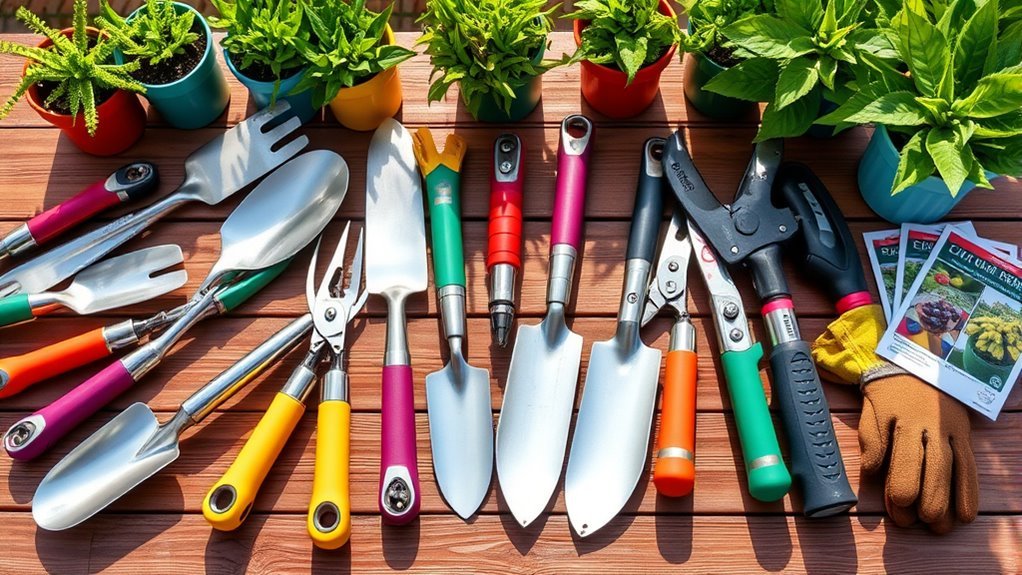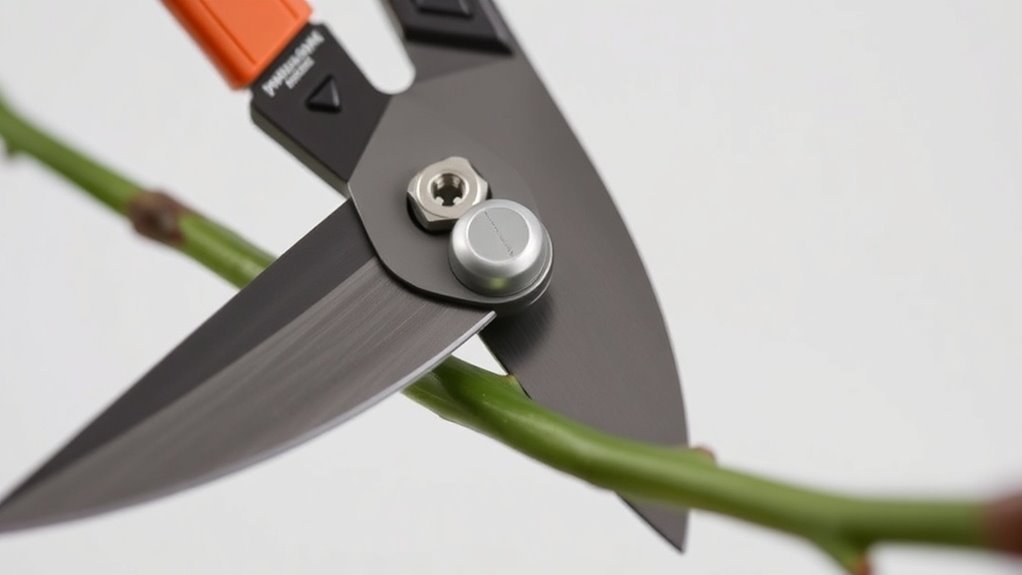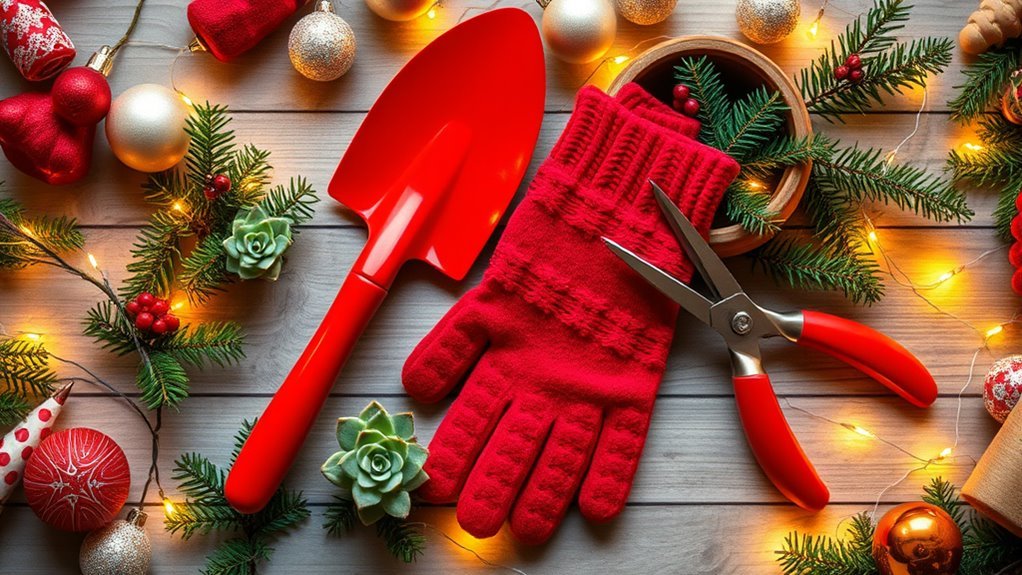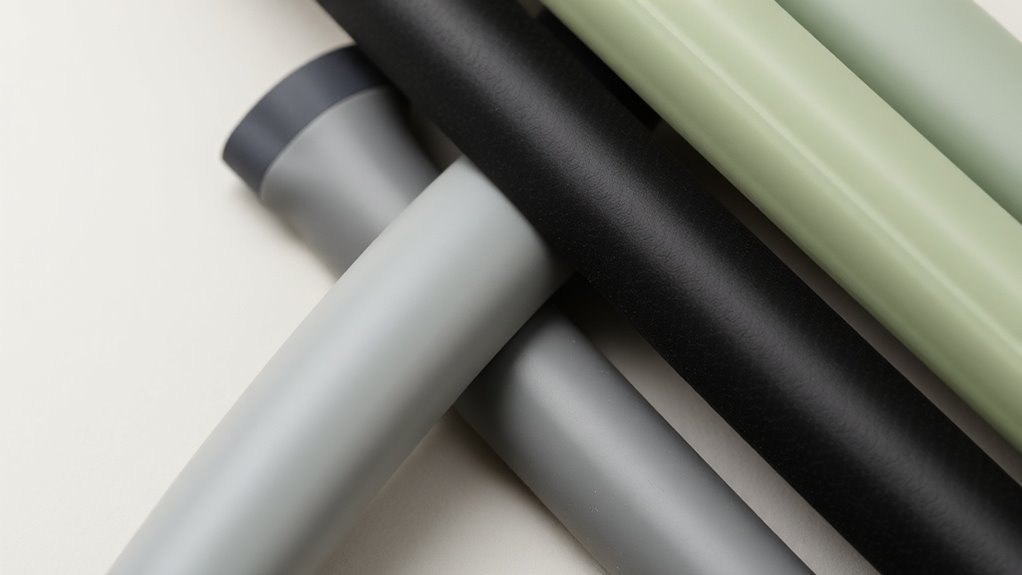Importance of Gloves and Safety Gear in Gardening
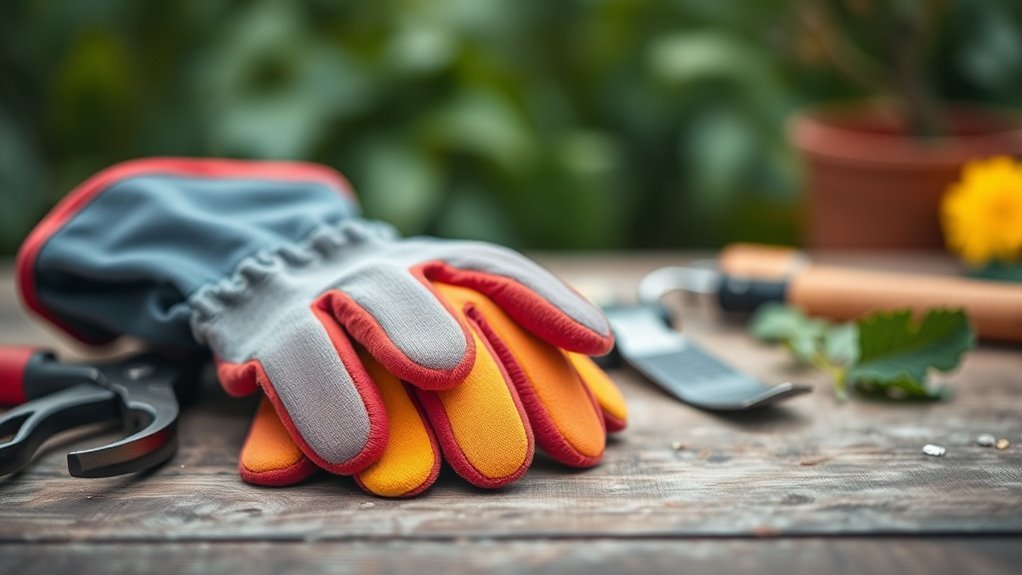
Wearing gloves and safety gear in gardening is essential for protecting yourself from cuts, irritants, and other hazards. Your hands, being the most valuable tools, need protection from thorns and chemicals. Proper footwear keeps you safe from slips, while eye protection guards against flying debris and harmful exposure. Additionally, using knee pads adds comfort during extended tasks. By prioritizing your safety with the right gear, you can enhance your gardening experience. There’s much more to explore on how to garden safely!
Key Takeaways
- Gardening gloves protect hands from cuts, thorns, and irritants while improving grip and control during tasks.
- Safety gear, like long-sleeved shirts, shields skin from allergens and chemical exposure.
- Proper footwear prevents slips and injuries, ensuring stability on uneven terrain.
- Eye protection safeguards vision from debris, chemicals, and sun exposure while gardening.
- A safety checklist helps identify hazards and ensures readiness against potential injuries in the garden.
The Importance of Hand Protection
When you dig your hands into the soil, it’s easy to forget that protection is key. Your hands are your most valuable tools in gardening, but they’re also vulnerable to cuts, blisters, and exposure to harmful chemicals or thorny plants.
Wearing gloves doesn’t just keep your hands clean; it safeguards against injuries that could hinder your gardening passion. You might encounter sharp objects, biting insects, or even poison ivy lurking beneath those pretty flowers.
Plus, the right gloves can help improve your grip, making it easier to maneuver tools and seedlings. Furthermore, just as effective respiratory protection is vital in DIY work, proper hand protection is essential to avert health risks related to gardening activities, such as exposure to harmful chemicals. So, before you start digging, planting, or pruning, remember that proper hand protection is essential to keeping your hands safe and healthy throughout all your gardening adventures.
Choosing the Right Gardening Gloves
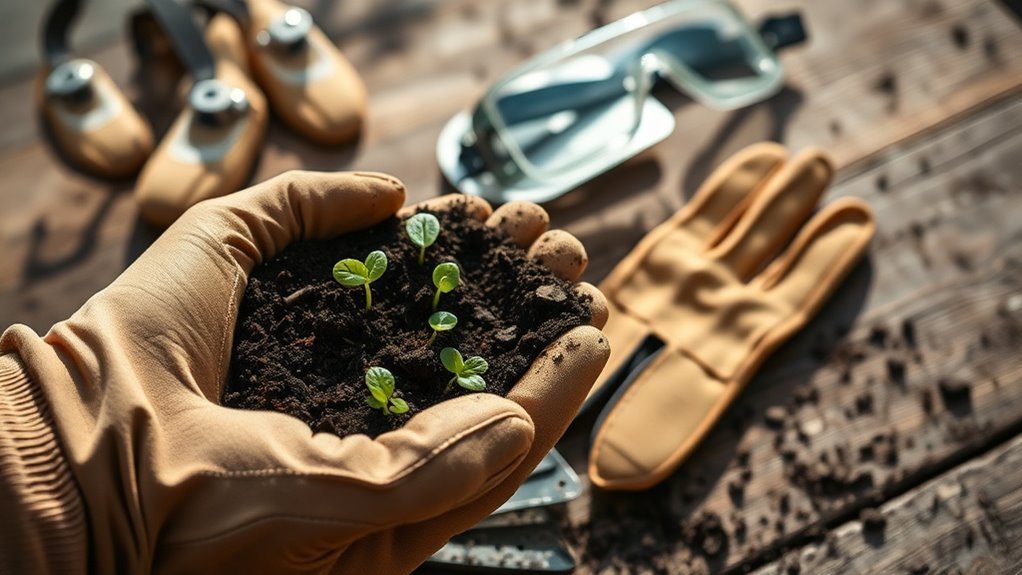
When it comes to gardening gloves, the right material and fit can make all the difference. You’ll want to take into account what tasks you’ll be doing, as different materials offer various levels of protection and flexibility. Plus, making sure you choose the right size guarantees comfort, so you can keep your focus on your garden. Choosing gloves made from the right material is essential for ensuring adequate protection against chemical hazards and providing the necessary dexterity for handling tools and plants.
Material Types Explained
Selecting the right gardening gloves is essential for protecting your hands while you work in the soil.
Different materials offer various benefits and should suit your gardening tasks. Here are four common glove materials to evaluate:
- Leather – Durable and ideal for heavy-duty work, yet may be less flexible.
- Cotton – Breathable and comfortable, perfect for light gardening tasks, but provides little protection against thorns or chemicals.
- Latex – Offers great grip and dexterity, making them suitable for handling delicate plants but may not withstand rough tasks.
- Nitrile – Water-resistant and puncture-resistant, a great choice for wet conditions, combining functionality with comfort.
Choosing the right material can considerably enhance your gardening experience while keeping your hands safe.
Size and Fit Considerations
Finding the right size and fit for your gardening gloves is just as important as choosing the right material. If your gloves are too tight, they’ll restrict your movement and cause discomfort.
On the other hand, gloves that are too loose might slip off or make it difficult to grip tools effectively. To guarantee a good fit, measure your hand’s width and length, usually just above the knuckles.
Most brands provide a sizing guide, so check that before buying. It’s also a good idea to try on gloves when possible; look for those with adjustable wrist straps for a secure fit.
Protecting Your Skin From Irritants
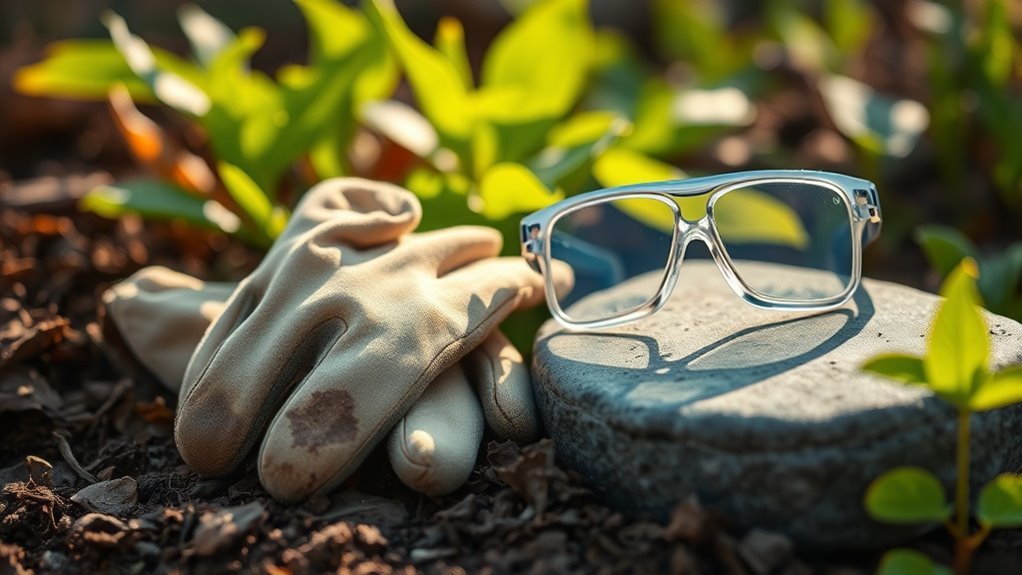
Even though gardening is a rewarding hobby, it can expose your skin to various irritants like thorns, pesticides, and allergens. To protect your skin, you should take a few precautionary steps.
Gardening is fulfilling but can expose your skin to irritants; precautionary steps are essential for protection.
Here’s a quick list of ways to keep your skin safe while digging in the dirt:
- Wear gloves: Choose gloves that fit well and cover your wrists to block out irritants.
- Use long sleeves: Lightweight long-sleeved shirts can shield your arms from scratches and chemicals.
- Apply barrier creams: These can prevent skin irritation from substances you might encounter.
- Hydrate your skin: Keeping your skin moisturized can help it resist irritants and reduce redness.
Following these tips can make your gardening experience more enjoyable and safer!
Footwear Safety in the Garden
While protecting your skin is essential in gardening, don’t overlook the importance of proper footwear. Your feet are your foundation. Wearing suitable shoes can prevent slips, punctures, and injuries. The choice of footwear is crucial in enhancing safety standards while engaging in various gardening tasks.
Here’s a quick guide to footwear safety in the garden:
| Type of Footwear | Benefits | Considerations |
|---|---|---|
| Waterproof Boots | Keep feet dry and warm | Ascertain they’re breathable |
| Steel-Toed Shoes | Protect against heavy items | May feel heavy during extended use |
| Garden Clogs | Easy to slip on/off | Not suitable for rough terrain |
| Sneakers | Comfortable for long wear | May lack support in muddy areas |
Eye Protection: Why It Matters
Many gardeners underestimate the importance of eye protection, but it’s essential for keeping your vision safe.
Gardening can pose hidden dangers—always prioritize eye protection to safeguard your vision as you nurture your plants.
While tending to your plants, you expose your eyes to various hazards that can lead to serious injuries. Here are four reasons why you should always wear proper eye protection:
- Flying Debris: Tools or soil can kick up particles that may injure your eyes.
- Chemical Exposure: Pesticides or herbicides can splash into your eyes, causing irritation or damage.
- UV Rays: Prolonged exposure to sunlight can lead to eye disorders; sunglasses can shield your peepers.
- Plant Materials: Thorns and branches can easily scratch or poke your eyes while you work.
Additionally, choosing the right lens types can enhance your eye protection based on your specific gardening activities. Don’t take chances—invest in a good pair of safety goggles or glasses and protect your sight!
Preventing Cuts and Scrapes
When you spend time in your garden, protecting your hands is key to avoiding cuts and scrapes.
Wearing the right gloves and safety gear can make a huge difference, especially when you know how to spot potential hazards. Additionally, following essential safety tips like proper handling of tools can significantly reduce the risk of injuries.
Let’s explore the best ways to keep your hands safe while you enjoy your gardening tasks.
Protecting Hands With Gloves
Gardening can be a rewarding experience, but it often comes with the risk of cuts and scrapes. To keep your hands safe, wearing gloves is vital. They not only provide a protective barrier against sharp tools and thorny plants, but they also help prevent dirt and bacteria from irritating your skin.
Here are some key benefits of using gloves while gardening:
- Protection from Cuts: Prevents injuries from sharp tools or branches.
- Improved Grip: Guarantees better control when handling tools.
- Barrier Against Irritants: Shields skin from harmful chemicals and plant toxins.
- Comfort: Offers cushioning to reduce fatigue during long sessions.
Choosing the Right Gear
How can you guarantee your safety while tending to your plants? Choosing the right gear is vital to preventing cuts and scrapes. First, invest in durable gardening gloves that fit well and provide good grip; they can protect your hands from thorns and sharp tools.
Look for gloves made of leather or heavy-duty synthetic materials for better protection.
Next, consider wearing long sleeves and pants to shield your skin from prickly plants and branches. Protective footwear, like sturdy boots, is essential to guard against injuries from sharp objects and uneven terrain.
Don’t overlook the importance of eye protection, especially when using tools that might send debris flying. With the right gear, you’ll enjoy gardening while minimizing injuries.
Identifying Potential Hazards
Even with the right gear, being aware of potential hazards in your garden is key to preventing cuts and scrapes.
Here are some common risks you should watch out for:
- Sharp Tools: Keep your blades and shears properly maintained to avoid accidents.
- Thorny Plants: Handle roses and brambles with extra caution; their thorns can easily prick your skin.
- Uneven Terrain: Be mindful of roots, rocks, or uneven soil, as they can cause trips and falls, leading to cuts.
- Pesticides and Chemicals: Always store these substances safely; spills can lead to skin irritation or harm.
Ergonomics and Comfortable Gear
While tending to your garden can be a rewarding experience, it’s essential to prioritize ergonomics and comfort to prevent strain and injury. Using well-fitted gloves and supportive footwear can make a big difference.
Look for gardening gloves that aren’t too tight, allowing for flexibility while keeping your hands protected. A cushioned kneeler or kneeling pad can save your knees during planting or weeding.
Consider long-handled tools to minimize bending and reaching, making gardening tasks easier on your back. If you’re gardening for long periods, take breaks to stretch and hydrate. Thoughtful designs in ergonomic products can enhance your gardening efficiency even further.
Incorporating these ergonomic practices won’t only enhance your gardening experience but also help you enjoy your time outdoors without discomfort. Your body will thank you!
Dealing With Allergens and Pests
When you’re out in the garden, allergens and pests can be a real challenge.
Wearing gloves not only protects your skin from irritants but also helps you manage insect encounters safely.
Knowing effective pest control techniques is key to keeping your garden healthy while minimizing exposure to allergens.
Allergens and Skin Protection
Gardening can be a fulfilling hobby, but it also exposes you to various allergens and pests that can irritate your skin. To protect yourself, consider using proper gloves and safety gear.
Here are some essential tips to help you deal with allergens:
- Choose breathable gloves: Look for gloves made from cotton or synthetic materials to prevent irritation.
- Wear long sleeves: Protect your arms from plant oils and allergens by wearing long-sleeved shirts.
- Use barrier creams: Apply barrier creams on exposed skin before gardening to minimize reactions.
- Wash hands after gardening: Always wash your hands thoroughly to remove any allergens and prevent skin irritation.
Pest Control Techniques
Many gardeners face challenges with pests that can disrupt their plants and lead to allergic reactions. Effective pest control techniques are essential for maintaining a healthy garden while minimizing allergens. You can adopt natural methods such as introducing beneficial insects or using homemade organic sprays. Always wear gloves and long sleeves while applying any treatments to protect yourself.
Here’s a quick comparison of common pest control techniques:
| Technique | Pros |
|---|---|
| Beneficial Insects | Eco-friendly, sustainable |
| Neem Oil | Reduces pests, safe for plants |
| Diatomaceous Earth | Non-toxic, effective against bugs |
Utilizing Knee Pads for Garden Work
Knee pads can be a game-changer for anyone spending long hours in the garden. They provide essential support and comfort, helping you to work more effectively and avoid injury.
Here’s why you should consider utilizing knee pads:
- Comfort: They cushion your knees against hard surfaces, reducing pain and fatigue.
- Support: Knee pads maintain proper alignment, preventing strain during bending or kneeling.
- Durability: Most knee pads are made from sturdy materials that withstand rough outdoor conditions.
- Convenience: Many designs are lightweight and easy to wear, making them a hassle-free addition to your gardening gear.
Investing in a good pair of knee pads can greatly enhance your gardening experience and protect you while you enjoy your time in the garden.
Creating a Safety Checklist for Gardening
Long hours spent gardening demand not just comfort from knee pads but also careful attention to safety. Creating a safety checklist can help you stay organized and minimize risks. Here’s a quick guide to guarantee you’re equipped properly before you start:
| Item | Purpose | Status |
|---|---|---|
| Safety Gloves | Protect hands from cuts | ✅ |
| Gardening Boots | Prevent slips and injuries | ✅ |
| Eye Protection | Shield against debris | ❌ |
| Kneepads | Comfort during planting | ✅ |
| First Aid Kit | Address injuries quickly | ❌ |
Checking off these items guarantees you’re prepared for a rewarding gardening experience. Prioritizing safety keeps both you and your garden thriving!
Questions
Can I Use Regular Gloves Instead of Gardening Gloves?
You can use regular gloves, but they may not provide the same protection or durability as gardening gloves. If you’re handling prickly plants or chemicals, investing in proper gardening gloves is a smart choice.
How Often Should I Replace My Gardening Gloves?
You should replace your gardening gloves whenever they’re worn out or damaged, usually every season or after extensive use. Check for holes or thin spots to guarantee they still provide adequate protection while you work.
Are There Vegan Options for Gardening Gloves?
Absolutely, there’re vegan gardening gloves available, often made from materials like organic cotton or synthetic options free from animal products. Choosing them shows your commitment to kindness, nurturing both plants and the planet you love.
What Are the Best Brands for Gardening Safety Gear?
For the best gardening safety gear, consider brands like Fiskars, GardenSafe, and Gempler’s. Their gear’s durable, functional, and comfortable, ensuring you’re well-protected while enjoying your gardening activities without hassle or worry.
How Do I Clean and Maintain My Gardening Gloves?
Think of your gloves as trusty sidekicks. To clean them, hand-wash gently with mild soap in cool water, then air-dry away from direct sunlight. Regular maintenance keeps them durable and ready for your next gardening adventure!
Conclusion
In the world of gardening, just as a knight wouldn’t charge into battle without armor, you shouldn’t tend to your plants without proper safety gear. From gloves that shield your hands to eye protection that keeps you safe from debris, each piece plays an essential role in your gardening adventure. By prioritizing your safety, you not only enhance your experience but also guarantee your health. So gear up and embrace the joy of gardening without the worry of mishaps!

